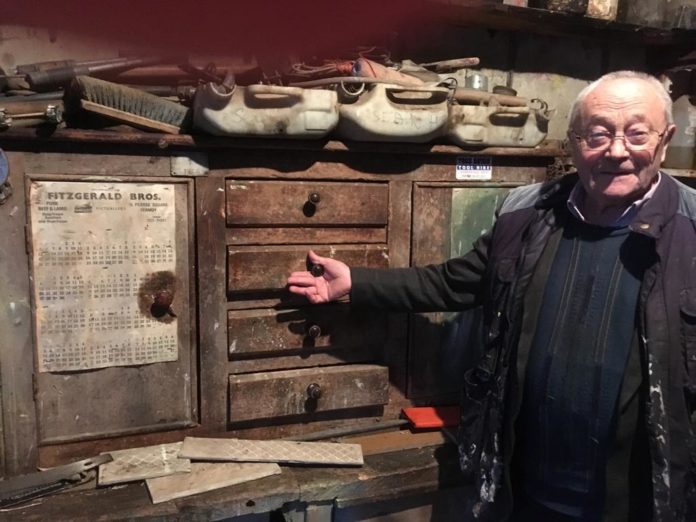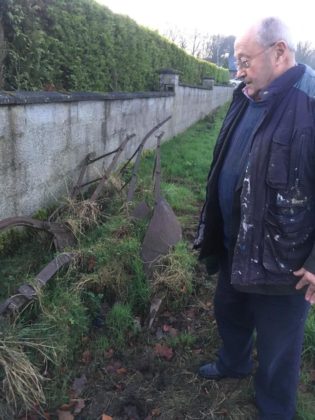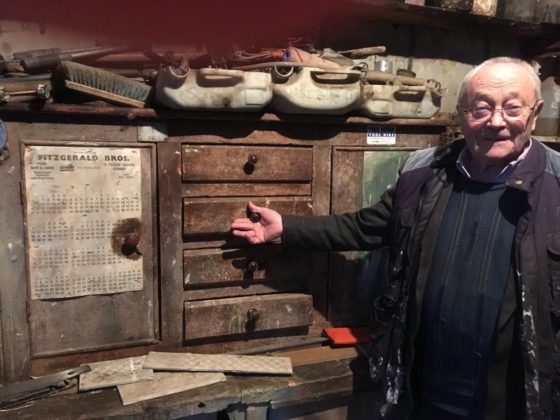
When tractors began to make their appearance on the agricultural scene in Ireland in the 1920s and ‘30s, and moreso into the ‘40s and ‘50s, the common horse-drawn car which was very much the regular mode of transport for moving agricultural produce at that time, or the more comfortable spring cart, were beginning to be phased out.
So too the horse and tumble-butt used for drawing the likes of mangolds, beet and turnips and of course, the smaller donkey cart. Even those who had the luxury of a pony and trap, would soon see these preserved for the museum or interpretive centre and being replaced by the motor car.
One man who had been very involved with the traditional modes of transport in those years is 83 year-old John Hyland from Castlecooke, Kilworth. John’s father was a wheelwright who worked from the home place in Castlecooke and so, had regular contact with farmers far and wide.
Their home, dating back to 1899, was once the gate lodge leading to the Cooke Collis estate and it was here the many wheels and associated wooden objects such as sideboards, shafts, tailboards etc., were turned out.
Other items made in their workshop would have been sash windows and hundreds of three-legged milking stools were turned out as they were used in every cow house, long before the word ‘milking parlour’ was coined.
John was born in October 1935 and was an only son. Of his four siblings (Maureen, Kathleen, Nellie and Bernadette), three of the four joined the nuns – two have since died (Kathleen and Nellie) while Maureen lives in England and Bernadette in Mitchelstown.
SCHOOL
John went to school in Coolmohan which meant either a two mile walk or a spin from one of the neighbouring farmers on the common car amid the churns going to the creamery in Araglin. Taking the spin meant a longer trip, rather than the shorter walking route via Paulie’s Hill.
John’s classmates included names such as Jim Donoghue (Ballinamadough), John Kenny, Jim Brien (later to become ‘Fr Jim’), their teachers being Mrs Sweeney, Mrs Moher and ‘Master’ Moher.
“Ireland was Ireland then,” John says, referring to the changing times and he has no problem in admitting that the regime at home was a strict one. “I didn’t get to a dance in a dancehall) until I was the best part of 21 but I wen to the stage near Mulveys from when I was 18 or so.”
THE DANCES
John fondly recalls the dances in Jack Allen’s Hall. “The well known hurler Johnny Browne from Castletownroche, had a band and he was a regular there. And we had a couple of great nights there with The Southlanders which had Sean Hegarty, Denny Brien, John Joe Cahill and Pierre Young in the line-up.”
John didn’t drink until he was well into his 20s and remembers the night he ‘broke’ his pledge. “It was in Ballyporeen. There was a few of us there and cider is what we drank,” he says, adding that while he hasn’t consumed alcohol for a god few years now, he liked a drink and was always fond of ‘the music. the dancing and the craic’.
The regular haunts for dancing would have been the aforementioned Allen’s Hall in Araglin and the village halls in Kilworth, Ballyporeen and Ballyduff, the Boathouse in Cappoquin and the Arch in Tallow. However, it was at The Mayflower in Mitchelstown in the early 1960s that John met Phil, the love of his life.
“From the first dance I had with her, I knew she was the only one for me,” John recalls so convincingly. However, not too long after they meeting, Phil (nee O’Brien) who lived ‘over the border’ in Ballinalukena (between Araglin and Ballysaggart), headed off to America.
“That was in 1964,” Phil informed this writer, explaining that she was asked over for the World Fair by a relation and informed John it would be ‘for three months’. “That was the biggest lie she ever told me,” John interrupted, explaining that her three month stint extended to no less than two years. However, having spent eighteen months or so working as a nurse’s aid, she arrived back home in 1966. The pair renewed their courtship and were married the following year.
“The day before our wedding, I piked no less than 74 winds of hay with Jim Moher on what was a scorching hot day, but the following day it rained out of the heavens for our wedding in Ballyduff chapel.”
The wedding reception was in Vienna Woods, Glanmitre and their two-destination honeymoon took them to Spain and Lourdes. They went on to have five in family – three boys – Sean who carried on the carpentry tradition, Aidan and Dermot are both plasterers – all three live just up the road from the home place; Bernadette lives in Kilworth and Veronica lives in Dripsey. “We have been blessed with 12 grandchildren and I must say, they are our pride and joy,” John proudly relates.
STRICT
While his parents might have been strict, he admits to having learned a lot from his father. “He was very particular and always insisted, that if a job is worth doing, it’s worth doing right”.
As well as their carpentry work, they ran a 35 acre farm so there were cows to be brought in and milked, turnips and mangolds had to be planted, thinned and when fully grown, had to be pulled and ‘saved’. The ploughing and harrowing had to be done, potatoes had to be planted and later picked. For the planting of the potatoes, they relied on the expertise of their near neighbour Mrs Crowley (grandmother of the Shanahan family), who was an expert at cutting ‘sciolláns’. They reared and cured their own bacon which meant black puddings and bacon was shared out locally.
John rattled off the parts that made up the wheels for the common car that his father made. “There was the stock (the centre piece that held the spokes) and that was made from elm which was very hard timber and very well seasoned; we morticed those ourselves, a job that had tom be very meticulous.
The spokes were made of oak and the parts that made up the rim was made from elm. Then you had also to make the dowels and wedges. These and the spokes were tricky jobs,” he explained, adding that the shafts for the cars were usually made from larch.
“In October/November time, we would go down to Deenahan’s Wood and fell the trees. These would then be ready for planking or splitting the following summer.”
When the wheels were completed, John said the iron banding would usually be done by Mick Bowes in Fermoy or Skully Kenneally at the Mountain Barracks. The decorative paint work was usually undertaken by Stritch’s, Fermoy. Another job was making the swings and the pins for the ploughs and the common harrow, usually from elm, oak and larch.
“Thanks to Hitler and the war, the iron bands were replaced with rubber and we used to band the wheels with rubber here in the workshop after that.”
LONG LIFE
John’s dad passed away suddenly aged 92 on the third anniversary of his mother’s death. John’s grandfather lived to the ripe old age of 100, his grand-aunt to 101, “so I’m hoping to be around for a while yet,” he says wryly.
In the workshop, John pointed out part of an old dresser that had been made by his father from cherry wood. “Cherry wood was beautiful timber to work with and gave a beautiful finish,” John said, adding that the dresser was still being used for storing bits and pieces.
With work being high on the agenda, John didn’t play as much sport as he would like to have done, but played minor football at corner-back with Kilworth under the guidance of Bill ‘The Boss’ Magnier. Some other on the team would have included Chris Lomasney, Ter Kenny, Tom Halloran, John Carey, the Farrens and the Keaveneys.
He also played with Araglin and remembers a great game that they won against Mitchelstown with Jim O’Mahony, Paddy Brien and Ned Donoghue on the team, “Ter Kenny was the captain – he still has the cup to this day!”
THE ALTARS
In the 1960s, the Catholic Church saw a number of major changes – one being the ‘turning around’ of the altars so that the priest faced the people. John was involved in ‘the turning around of the altars’ between ’68 and ’70 with Martin Brennan, Paddy Hyland and Dave Prior and it was while on this mission that he had a narrow escape from death.
“We were working in Tallow for the Nuns. It was in 1971 and there was a tree on the grounds that was causing them a bit of concern. I volunteered to take down the tree for them but in doing so, the tree fell the wrong way and caught me. I would up with a broken hip and spent 6 months in plaster up to the top of my chest. That was hard going but nevertheless, I manged to get in a few small jobs while I was recouperating.
John also worked in Moorepark with Teagasc and enjoyed his time and the camaraderie there. He spent 12 years in total there, doing blockwork, plastering, tiling general maintenance work.
John was very involved with the community councils in both Araglin and Kilworth for a good number of years. “I learned a lot there and would encourage anyone to become involved because good community spirit means an awful lot,” he says.
Though not as agile as he once was, John still tends to the garden and keeps enough logs split with the help of a log-splitting machine to feed the stove in the sittingroom. He still hasa great interest in items of old machinery and is presently contemplating restoring three ploughs and a scuffler.
“My hands have got very stiff so it’s not as easy to tackle these kind of jobs,” John says, pointing out that he keeps doing regular exercises for his hands. “You have to keep doing these things, otherwise you’d seize up,” he professes.
With a spirit like John has, he has no intention of standing still just yet. We wish John and Phil long life and continued good health for many years to come.










